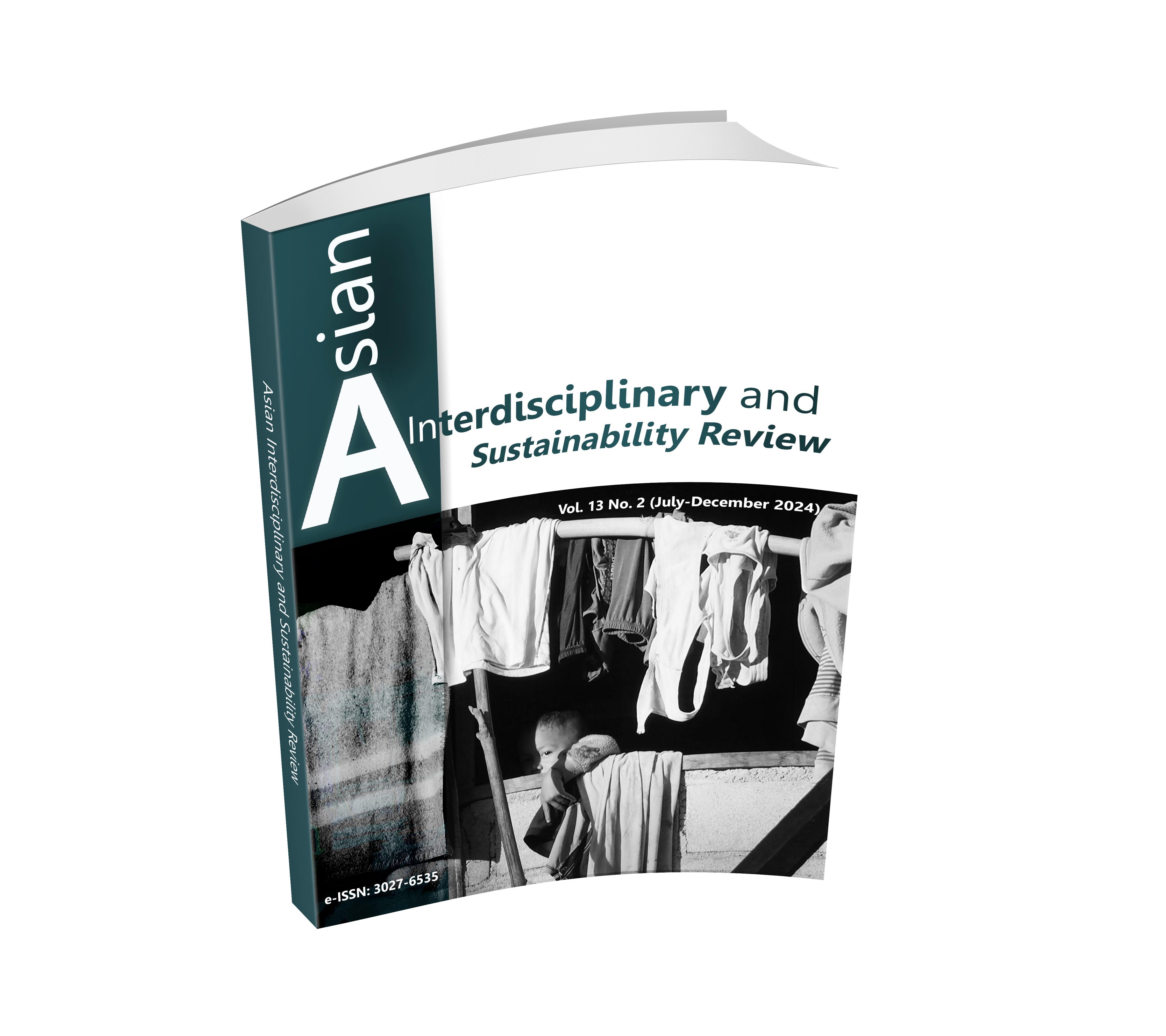ANTECEDENTS OF TRUST AND THEIR EFFECTS ON PURCHASE INTENTION OF SKINCARE PRODUCTS THROUGH INSTAGRAM APPLICATION
DOI:
https://doi.org/10.14456/aisr.2024.15Keywords:
E-Commerce, Trust, Instagram, SkincareAbstract
This study aims to investigate the factors influencing trust and the purchase intention of skincare products through the Instagram application. The study employed a quantitative research methodology, collecting data via online questionnaires from 400 consumers who purchased skincare products through the Instagram application. Data analysis included statistical methods such as frequency, percentage, mean, standard deviation, and path analysis. The research findings indicated that trust was a significant factor influencing the purchasing intention of skincare products through the Instagram application with statistical significance at the .01 level. Additionally, e-commerce knowledge and perceived ease of use had an indirect influence on the purchasing intention of skincare products through the Instagram application with statistical significance at the .01 level. Perceived risk had an indirect influence on the purchasing intention of skincare products through the Instagram application with statistical significance at the .05 level.
Downloads
References
Charoensereechai, C., Nurittamont, W., Phayaphrom, B., & Siripipatthanakul, S. (2022). Understanding the Effect of Social Media Advertising Values on Online Purchase Intention: A Case Study of Bangkok, Thailand. Asian Administration and Management Review, 5(2), 1-11.
Chiang, K., & Dholakia, R. (2003). Factors driving consumer intention to shop online: An empirical investigation. Journal of Consumer Psychology, 13(1-2), 177-183.
Chun, R. (2005). Corporate reputation: Meaning and measurement. International Journal of Management Reviews, 7(2), 91-109.
Cochran, W. (1977). Sampling Techniques. 3rd ed. New York: John Wiley & Sons.
Crespo, A., Bosque, I., & Sánchez, M. (2009). The influence of perceived risk on Internet shopping behavior: a multidimensional perspective. Journal of Risk Research, 12(2), 259-277.
Das, G. (2014). Impacts of retail brand personality and self-congruity on store loyalty: The moderating role of gender. Journal of Retailing and Consumer Services, 21(2), 130-138.
Electronic Transactions Development Agency. (2020). Results of the 2020 internet usage survey in Thailand. Retrieved from www.etda.or.th/th/newsevents/pr-news/ETDA-released-IUB-2020.aspx.
Fatmawati M, I., & Ali, H. (2021). Determination Attitude Toward Using and Purchase Intentions: Analysis of Perceived Ease of Use and Perceived Usefulness (Case Study of Instagram Shop’s Features on Social Media Instagram). Dinasti International Journal of Management Science, 3(1), 119-133.
Gefen, D. (2003). TAM or Just Plain Habit: A Look at Experienced Online Shoppers. Journal of Organizational and End User Computing, 15(3), 1-13.
Gerber, C., Ward, S., & Goedhals-Gerber, L. (2014). The impact of perceived risk on on-line purchase behaviour. Risk Governance & Control: Financial Markets & Institutions, 4(4-1), 99-106.
Helm, S., Garnefeld, I., & Tolsdorf, J. (2009). Perceived Corporate Reputation and Consumer Satisfaction - an Experimental Exploration of Causal Relationships. Australasian Marketing Journal, 17(2), 69-74.
Huang, Y., Bunchapattanasakda, C., Suo, L., & Boonmek, B. (2024). The Influence of Social Media Marketing on Purchase Intentions Through Consumer Engagement. Asian Administration and Management Review, 7(2), 45-55.
Huseynov, F., Huseynov, S., & Özkan, S. (2016). The influence of knowledge-based e-commerce product recommender agents on online consumer decision-making. Information Development, 32(1), 81-90.
Iqbal, W. (2019). Impact of perceived risk on customer’s online purchase intention towards branded apparels. Journal of Marketing Strategies, 1(1), 38-62.
Jaradat, M., & Faqih, K. (2014). Investigating the Moderating Effects of Gender and Self Efficacy in the Context of Mobile Payment Adoption: A Developing Country Perspective. International Journal of Business and Management, 9(11), 147-169.
Jiang, P., & Rosenbloom, B. (2005). Customer intention to return online: price perception, attribute‐level performance, and satisfaction unfolding over time. European Journal of Marketing, 39(1/2), 150-174.
Khwunnak, C., & Intanai, S. (2023). The Influence of Technology Adoption and the Perceived Value of Websites on Consumer Purchasing Decisions in B2C E-Commerce. NEU Academic and Research Journal, 13(2), 89-103.
Kusumah, R. (2015). Analyze the effect of trust, price, quality and perceived risk toward consumer purchase behavior in online shops Instagram. Jurnal Berkala Ilmiah Efisiensi, 15(5), 334-495.
Lin, K., & Lu, H. (2011). Why People Use Social Networking Sites: An Empirical Study Integrating Network Externalities and Motivation Theory. Computers in Human Behavior, 27(3), 1152-1161.
McCole, P. (2002). The role of trust for electronic commerce in services. International Journal of Contemporary Hospitality Management, 14(2), 81-87.
Pankham, S., & Traisab, K. (2021). The influence of causal factors on purchasing intention of a used car via Facebook fanpage of consumers in Bangkok and its vicinity. Journal of Social Science and Buddhistic Anthropology, 6(5), 225-238.
Parasuraman, A., & Grewal, D. (2000). The impact of technology on the quality-value-loyalty chain: A research agenda. Journal of the Academy of Marketing Science, 28(1), 168-174.
Pavlou, P. (2003). Consumer acceptance of electronic commerce: Integrating trust and risk with the technology acceptance model. International Journal of Electronic Commerce, 7(3), 101-134.
Ramanjaneyulu, K., & Naseema, P. (2016). E-commerce: It’s impact on consumer behavior. St.Johns College of Engineering & Tech, 1(2), 1-6.
Rotchanakitumnuai, S. (2020). Factors Influencing Information Sharing in Online Social Network: The Case of Fact and Fake News. Journal of Business Administration, 43(167), 1-15.
Salam, A., Iyer, L., Palvia, P., & Singh, R. (2005). Trust in e-commerce. Communications of the ACM, 48(2), 72-77.
Statista. (2023). Instagram usage statistics. Retrieved from www.statista.com/statistics/instagram-usage-statistics.
Sun, X. (2022). Consumer Intention and Usage Behavior of Live-Streaming Shopping: An Extension of the Unified Theory of Acceptance and Use of Technology. The Journal of Behavioral Science, 17(3), 106-124.
Teskayan, P., & Oottamakorn, C. (2020). Factors relating to consumer behavior affecting the intention to visit and intention to purchase through social commerce: The roles of momentary characteristic and persistent characteristic. Journal of Suvarnabhumi Institute of Technology (Humanities and Social Sciences), 6(2), 164-177.
Thamma, N., Anywatnapong, W., Tunpornchai, W., & Saetang, C. (2024). Transforming E-Commerce: Artificial Intelligence Effect on Purchase Decision and Happiness. Asian Administration and Management Review, 7(1), 133-144.
Trí, L., & Lộc, V. (2013). Factors influencing the trust of young customers while using e-commerce websites. Ho Chi Minh City Open University Journal of Science, 3(1), 80-95.

Downloads
Published
How to Cite
Issue
Section
License
Copyright (c) 2024 Authors

This work is licensed under a Creative Commons Attribution-NonCommercial-NoDerivatives 4.0 International License.











.png)


